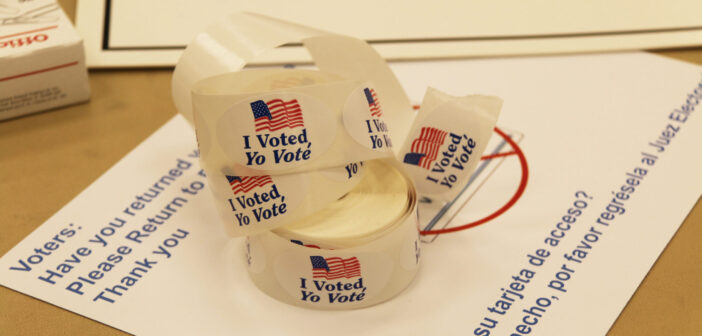The Brown and White has compiled an overview of the voting counting process on the Pennsylvania state website.
Election officials will begin pre-canvassing Northampton County’s votes on Nov. 5 at 7 a.m. in the cafeteria of the Government Center, 669 Washington St., Easton, PA.
Per state law, Pennsylvania prevents election officials from pre-canvassing until 7 a.m. on Election Day. In total, 43 states allow counties to begin the pre-canvassing process before election day.
Pre-canvassing is the process that includes verifying the validity of ballots and preparing them to be read by the ballot counting machines.
Per Act 88 in Pennsylvania’s election code, canvassing and vote totaling will begin at 8 p.m. and continue until each ballot has been counted. All votes cast in person at the polls will be recorded on the machines.
No part of the voting system is connected to the internet. After the pre-canvassing process is completed for all mail-in and absentee ballots, they will be tallied using voting counting machines, which are tested through a Logic and Accuracy Assessment ahead of election day.
The election code also stipulates that the county board of elections will announce the unofficial number of absentee ballots and mail-in ballots received for that election by 12:01 a.m. on the day after the election.
Northampton County will also post unofficial results to its website at 8 p.m., updating them as they come in.
If any registered Pennsylvania voter believes their rights have been violated, is aware of potential voter fraud or has a complaint about how the election is conducted, they can report it via an online form. This system empowers voters to play an active role in ensuring the integrity of the election process.
On Friday, Nov. 8, all 67 county boards of election will publicly begin the official computation of election results, a process designed to be transparent and open to public scrutiny. To ensure election transparency and integrity, the counties will all conduct two different types of audits, a 2% statistical audit and a statewide risk-limiting audit (RLA), before the results are certified.
A 2% statistical audit, which is required by State law, involves the county board of election pulling a random sample of either 2% of all the ballots cast in all the races or a random sample of 2,000 ballots, whichever number is fewer.
The RLA states that each county’s conduct is designed to conform to election outcomes. To ensure the vote-counting machines report the correct outcomes, a random sample of paper ballots and the results produced by the counting machines are examined.
Then, each county will report its final certified results to Pennsylvania state election officials, who will send state totals to the Federal Elections Committee.
The FEC, an independent regulatory agency, will then publish the Federal Election, a biennial compilation of official, certified federal election results, including the primaries, any runoff election, and the general election results of the Senate, the House of Representatives, and the President.
While the Associated Press will call states by declaring winners as state election officials report their certified results, the presidential election results will not be official until the electoral college votes. Each state has the same number of electors as representatives in Congress, with three more electors for the District of Columbia.
Per the Electoral Count Act, each state’s electors will meet at their respective state capitals on the first Tuesday after the second Wednesday to cast their votes. The Electoral College, a group of electors chosen by the political parties in each state, plays a crucial role in the election process. This year, they will vote on Dec.17 to select the President and Vice president of the United States.
The updated Electoral Count Reform Act, passed by Congress in 2022, requires state officials to certify the states’ appointment of electors to Congress no later than six days before the date the Electoral College is set to meet. The updated ECRA aims to clarify the original act from 1887 by outlining the roles of state and federal officials and federal courts in the presidential election process.
Federal law does not require electors to vote in a way that reflects the results of their state.
However, according to the Library of Congress, 38 states and the District of Columbia have laws requiring electors to vote for the candidates for whom they pledged to vote.
Every state except Maine and Nebraska follows the “winner-takes-all rule,” which stipulates that all electoral college votes are won by whichever candidate wins the popular vote. Maine and Nebraska drive their electoral votes based on how many districts a candidate wins, plus two additional ballots from the statewide winner.
Typically, electorates pledge to vote for whoever has won their state based on either the “winner-takes-all rule” or the proportional rule, and then they cast their vote following their pledge.
In 2016, seven faithless electors ultimately voted against the candidate who had won their state.
Congress will then certify the votes on January 6. If there is a tie, the House of Representatives will hold a contingent election to choose the president.






Comment policy
Comments posted to The Brown and White website are reviewed by a moderator before being approved. Incendiary speech or harassing language, including comments targeted at individuals, may be deemed unacceptable and not published. Spam and other soliciting will also be declined.
The Brown and White also reserves the right to not publish entirely anonymous comments.
1 Comment
You said :In 2016, seven faithless electors ultimately voted against the candidate who had won their state.
The link shows no such thing; remove from article please.